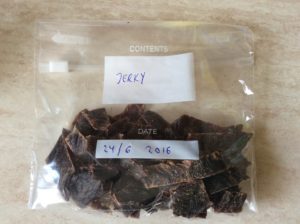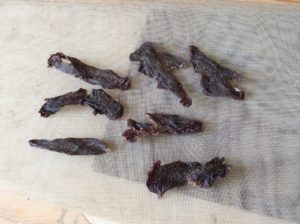Hey, what could possibly be more genuine provision on a hike than this classic? Dried meat has been used for thousands of years to provide sustenance to our hunter-gatherer ancestors and, together with dried fruit, berries and nuts actually prevented utter starvation during the lean months of winter when game was rare and hunting made difficult by the season.
The ability to preserve food through the process of dehydration made it possible for early humans to inhabit regions with harsher climate and has played a crucial role in humans conquering virtually every corner of the earth.
While we will address the dehydration and preparation of a wide variety of food on these pages, for me this is the natural place to start and I personally use jerky as a staple of my diet when on a hike that’s longer than just a few days. Going on a two or three day hike you could chose almost any food as neither the weight nor the risk of it getting spoiled (just avoid the most delicate food items that spoil extremely fast) needs to be considered for such a short hike.

So, keeping first things first, most important is to chose was kind of meat to use and, as the nutritional value of the foods we eat is what fuels our hike, it’s a no-brainer to chose the high quality stuff. Now, this has less to do with the cut and everything with the animal. Frankly you can use almost any cut, as long as it’s reasonably lean. Fat doesn’t get dehydrated and so choosing fattier cuts increases the weight and shortens the life span of the jerky, fat gets rancid which renders it inedible while lean cuts of meat gives you a jerky you can still use after a year or more of storage.
Still, of course, it’s recommended to use freshly made beef jerky and left overs a hike is a delicious and nutrient rich snack!
The fact that almost any lean cut can be used is a huge advantage when it comes to buying organic grass fed beef or game meat as the finer parts can be ridiculously pricy. Go for the parts around the thighs of the animal that we usually would cook roasts from and trim away any excess fat (if You want to go really hardcore here just melt that fat down and make tallow, You can even ask the butcher for more fat. That´s usually very inexpensive).

Then cut the meat in thin slices (3-5mm or 1/10-1/5 inch) and flavor them to Your preference. You can use virtually any kind of marinade or rub You normally use for barbecue, just make sure that You´re on top of the ingredients. There are more fun situations in the wild than getting a stomach upset from too much chili powder ?
Now, if You use a marinade the meat needs some extra time absorbing the fluid and also longer to dehydrate. Using a rub lets us get on with the process immediately and also saves time drying.
Usually we have two methods to chose from to dry our meat:
1) using a dehydrator – here, as always, it pays long term to go for quality. There are numerous different devices on the market and they differ between countries so you have to do your own homework here. Begin by determining the right size for your needs and do your due diligence. Once you purchased one, follow the instructions that come with it.
A word of caution here – many dehydrators are designed merely for mushrooms, veggies and some fruits and run on too low a temperature for drying meat. If in doubt always check again with the manufacturer before closing the deal.
2) using the oven – use a grate that fits the with of the oven and hang your slices of meat over the bars, rub the bars with some olive or coconut oil to prevent the meat from sticking and make cleaning the grate easier. Turn on the oven at low temperature, we want around 50 Celsius (120 Farenheit) to get the meat dehydrated and not cooked. Finally leave the oven door ajar about 10cm (4 inches) for the air to circulate and let the moisture out.
Despite some rumors that you can’t make jerky in a gas oven I’ve been doing that for years and it works just as well. I use the minimum heat and that level at about the right temperature.
The time needed for the process to complete itself depends on the amount of meat, the thickness of the slices and if you marinated or rubbed the meat. Ventilation and temperature also play in and I can only give you a very estimated time frame. In my experience it should be thoroughly dehydrated in 7-12 hours and usually it works fine to just leave it over night.
That leaves us with another two methods that require some special equipment or circumstances:
1) Drying the meat along the stovepipe or at the opening for the camp fire smoke (actually this is more a combination of smoking and drying that´s can be seductively tasty) of a cabin, tent, Native American tipi, Mongolian jurta or Sami kåta. Of course providing You having access to one of the above.
If not I highly recommend that You try the finished product if and when You get the opportunity. Smoked and/or dried reindeer meat is a delicacy in northern Sweden and I´m sure it´s equally good anywhere else You can get it!
2) Making the jerky utilizing the sun and wind might be the most ancient and traditional way of preserving meat. Naturally this only works in certain climates and I just started a promising looking experiment here on Cyprus. More about this in a later post though I can only encourage You to give it a go if You live where it might be possible. I just love the feeling of using original methods!
Good luck, have fun and love the experience!!!



 Then cut the meat in thin slices (3-5mm or 1/10-1/5 inch) and flavor them to Your preference. You can use virtually any kind of marinade or rub You normally use for barbecue, just make sure that You´re on top of the ingredients. There are more fun situations in the wild than getting a stomach upset from too much chili powder ?
Then cut the meat in thin slices (3-5mm or 1/10-1/5 inch) and flavor them to Your preference. You can use virtually any kind of marinade or rub You normally use for barbecue, just make sure that You´re on top of the ingredients. There are more fun situations in the wild than getting a stomach upset from too much chili powder ?